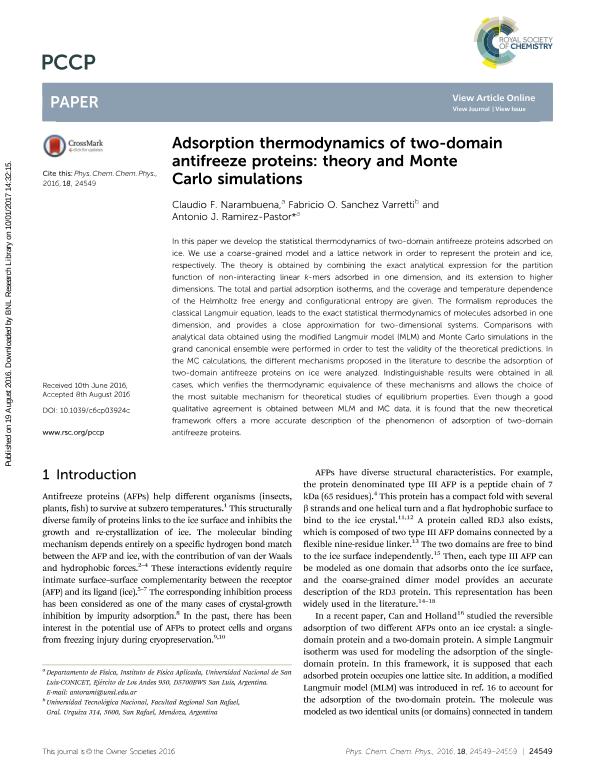Mostrar el registro sencillo del ítem
dc.contributor.author
Narambuena, Claudio Fabian

dc.contributor.author
Sanchez Varretti, Fabricio Orlando

dc.contributor.author
Ramirez Pastor, Antonio Jose

dc.date.available
2018-09-20T17:04:38Z
dc.date.issued
2016-08
dc.identifier.citation
Narambuena, Claudio Fabian; Sanchez Varretti, Fabricio Orlando; Ramirez Pastor, Antonio Jose; Adsorption thermodynamics of two-domain antifreeze proteins: Theory and Monte Carlo simulations; Royal Society of Chemistry; Physical Chemistry Chemical Physics; 18; 35; 8-2016; 24549-24559
dc.identifier.issn
1463-9076
dc.identifier.uri
http://hdl.handle.net/11336/60459
dc.description.abstract
In this paper we develop the statistical thermodynamics of two-domain antifreeze proteins adsorbed on ice. We use a coarse-grained model and a lattice network in order to represent the protein and ice, respectively. The theory is obtained by combining the exact analytical expression for the partition function of non-interacting linear k-mers adsorbed in one dimension, and its extension to higher dimensions. The total and partial adsorption isotherms, and the coverage and temperature dependence of the Helmholtz free energy and configurational entropy are given. The formalism reproduces the classical Langmuir equation, leads to the exact statistical thermodynamics of molecules adsorbed in one dimension, and provides a close approximation for two-dimensional systems. Comparisons with analytical data obtained using the modified Langmuir model (MLM) and Monte Carlo simulations in the grand canonical ensemble were performed in order to test the validity of the theoretical predictions. In the MC calculations, the different mechanisms proposed in the literature to describe the adsorption of two-domain antifreeze proteins on ice were analyzed. Indistinguishable results were obtained in all cases, which verifies the thermodynamic equivalence of these mechanisms and allows the choice of the most suitable mechanism for theoretical studies of equilibrium properties. Even though a good qualitative agreement is obtained between MLM and MC data, it is found that the new theoretical framework offers a more accurate description of the phenomenon of adsorption of two-domain antifreeze proteins.
dc.format
application/pdf
dc.language.iso
eng
dc.publisher
Royal Society of Chemistry

dc.rights
info:eu-repo/semantics/openAccess
dc.rights.uri
https://creativecommons.org/licenses/by-nc-sa/2.5/ar/
dc.subject
Adsorption
dc.subject
Monte Carlo Simulation
dc.subject
Antifreeze
dc.subject.classification
Otras Ciencias Físicas

dc.subject.classification
Ciencias Físicas

dc.subject.classification
CIENCIAS NATURALES Y EXACTAS

dc.title
Adsorption thermodynamics of two-domain antifreeze proteins: Theory and Monte Carlo simulations
dc.type
info:eu-repo/semantics/article
dc.type
info:ar-repo/semantics/artículo
dc.type
info:eu-repo/semantics/publishedVersion
dc.date.updated
2018-09-20T13:39:36Z
dc.journal.volume
18
dc.journal.number
35
dc.journal.pagination
24549-24559
dc.journal.pais
Reino Unido

dc.description.fil
Fil: Narambuena, Claudio Fabian. Consejo Nacional de Investigaciones Científicas y Técnicas. Centro Científico Tecnológico Conicet - San Luis. Instituto de Física Aplicada "Dr. Jorge Andrés Zgrablich". Universidad Nacional de San Luis. Facultad de Ciencias Físico Matemáticas y Naturales. Instituto de Física Aplicada "Dr. Jorge Andrés Zgrablich"; Argentina
dc.description.fil
Fil: Sanchez Varretti, Fabricio Orlando. Universidad Tecnologica Nacional. Facultad Regional San Rafael; Argentina. Consejo Nacional de Investigaciones Científicas y Técnicas; Argentina
dc.description.fil
Fil: Ramirez Pastor, Antonio Jose. Consejo Nacional de Investigaciones Científicas y Técnicas. Centro Científico Tecnológico Conicet - San Luis. Instituto de Física Aplicada "Dr. Jorge Andrés Zgrablich". Universidad Nacional de San Luis. Facultad de Ciencias Físico Matemáticas y Naturales. Instituto de Física Aplicada "Dr. Jorge Andrés Zgrablich"; Argentina
dc.journal.title
Physical Chemistry Chemical Physics

dc.relation.alternativeid
info:eu-repo/semantics/altIdentifier/doi/http://dx.doi.org/10.1039/C6CP03924C
dc.relation.alternativeid
info:eu-repo/semantics/altIdentifier/url/http://pubs.rsc.org/en/Content/ArticleLanding/2016/CP/C6CP03924C
Archivos asociados
